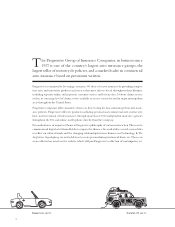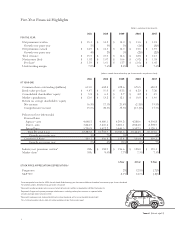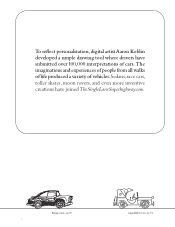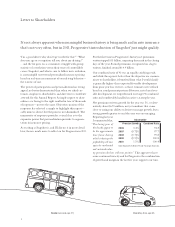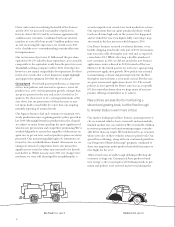Progressive 2011 Annual Report Download - page 13
Download and view the complete annual report
Please find page 13 of the 2011 Progressive annual report below. You can navigate through the pages in the report by either clicking on the pages listed below, or by using the keyword search tool below to find specific information within the annual report.
Product Potential
Product design differences between auto
insurance offerings are understandably obscure and certainly
less obvious than those of many consumer products. While
subtle for some, their importance and contribution are the
very essence of success in our business. Progressive, with some
justification, is well recognized in our industry as a leader
in product design and price segmentation. In large part, this
is the statistical matching of auto accident related costs
incurred by an individual to the premium to be paid. But
product design is much more than just price segmentation
and for us involves the consumer and agent presentation
and, increasingly so, their ability to interact with the product
by selecting and packaging combinations of coverage that
best meet their needs.
I doubt any year in Progressive’s history has
broadened the horizons of just what might be pos-
sible with future product design more than 2011.
I doubt any year in Progressive’s history has broadened the
horizons of just what might be possible with future product
design more than 2 011. The vast majority of the statistical
matching in use today is based on observable and verifiable
character istics of the driver and vehicle. While admittedly, it’s
the science of correlation and grouping, it has extraordinary
power and marginal improvements with disproportionate
gains are available to those truly committed to product research
and development. As good as the base science is, it lacked a
meaningful direct relationship to actual driving behavior.
Our work with measuring driver behavior, over now many
years, provided its share of challenges, but from the earliest
days suggested that, if possible and practical, the data set would
expand the known universe of rating segmentation. 2 011
was the year that possible and practical fully merged in our
product offering of “Snapshot.”
Snapshot, available in both our Agency and Direct channels,
has been met with significant consumer appeal. We’ve seen an
increasing number of Direct customers choosing to improve
their initial price estimate by installing our measurement
device and reporting their driving behavior. We provide the
policyholder a portal view into their trip management —
when, how many, how far, and selected variables of interest,
which for us are a proxy for defensive driving. After 30 days,
we are able to make an initial estimate of a discount that
reflects the individual’s driving characteristics and apply that
for immediate use. A final estimate is applied to the subse-
quent renewal and the measurement device is returned and
available for reuse, although we maintain a right for future
calibration. Discounts range between 0% and 30% and the
full range is effectively used. Perhaps more importantly, and
you’ll excuse me that certain specifics are best closely held,
the expectation of getting a discount is far better than 50/50,
suggesting, as I think we all intuitively know, that a smaller
percentage of drivers are responsible for a disproportionate
share of the costs. Identifying just who they are is the chal-
lenge we’re exploring. Accept ance by agents on behalf of their
customers is somewhat slower, and in many ways understand-
ably so, but as the product feature matures, I fully expect
increased consideration and use.
Snapshot is built on top of our existing product and, as such,
it is an additional level of segmentation rather than a product
in and of itself. The segmentation provided, however, is able
to be isolated and fully analyzed and tuned. Historically, data
quantity, management, and mining have been the keys to
effective segmentation and real-time usage data will be no
different, but the amplification of each is not for the faint
of heart. The data sets are huge, requiring storage, access, and
mining techniques that challenge those that only months
12
Caravan (Jens, age 43)RaceCar (Yorick, age 37)


